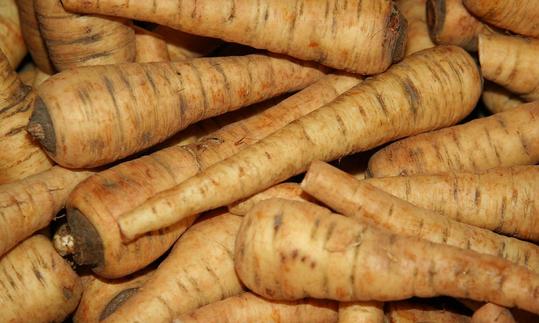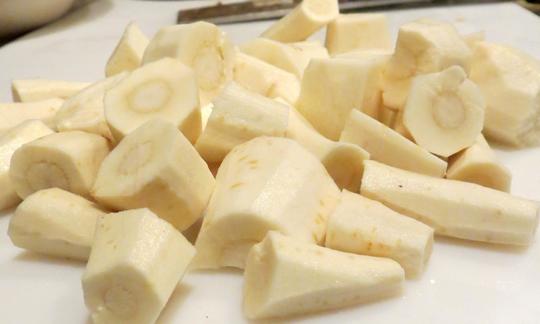Table of contents
The parsnip ( Pastinaca sativa ), also called parsnip , is often used in purees and soups. Raw, it goes well in salads - preferably in organic quality.
Use in the kitchen
The parsnip is a whitish to beige root or tuber vegetable. With its sweet, spicy, tart to nutty taste, it is reminiscent of celery and carrots .
How do you eat parsnips? They are very versatile in the kitchen. You can boil, stew, steam, fry, bake and prepare parsnips raw. Basically, you can use them in any vegetarian or vegan dish that you would normally use carrots for. Parsnips are particularly good in creamy soups (e.g. with apples , pears or chestnuts ), aromatic purees (plain or with potatoes ), hearty stews and casseroles. The following recipes are recommended: parsnip vanilla soup with thyme and almond milk , parsnip soup with pear, thyme and walnuts and raw vegan Jerusalem artichoke and parsnip cream soup with hazelnut milk . Also try oriental parsnip and potato puree .
Tasty chips (e.g. seasoned with a little thyme or rosemary ), oven-baked vegetables (e.g. with carrots, celery, beetroot , red onion ), and stir-fried vegetables (e.g. with Brussels sprouts ) can also be prepared with the root vegetable. Parsnips also taste excellent as a side dish - e.g. parsnip and spinach vegetables with walnuts on green spelt or briefly fried with garlic and ground nutmeg . They can also be used as part of a curry (e.g. parsnip and coconut curry with cauliflower and walnuts ) or made into a spread. The root vegetable combines well with spices and flavors such as chili , curry , harissa or mustard . The sweetness of agave syrup goes perfectly with it.
Can you eat parsnips raw? Is parsnip edible raw? Parsnips are edible raw. Cut into small strips or grated, raw parsnips go well with all kinds of salads (e.g. with carrots, celery, fennel or apples). It is also used raw, cut into thin spirals as a low-carb pasta substitute and chopped finely as a raw rice substitute (e.g. Thai-style rice salad with parsnip, pineapple and ginger ).
Amazingly, you can also create desserts with the white root vegetable. Various creams (e.g. with lemons , apples, oranges or vanilla ), cakes (e.g. with chocolate or carrots), but also fine sorbets can be prepared with parsnips.
Parsnips should generally not be peeled, as most of the flavour and nutrients are found directly under the skin. Small, young parsnips that can be roughly scrubbed clean with a vegetable brush are therefore preferable. 1 The skins of larger parsnips can be thick and hard, so it is better to remove them finely for an optimal mouthfeel. You should also cut out both ends of the parsnips and any dark spots (these are usually bland and woody).
Vegan recipe for raw parsnip spaghetti with avocado pesto
Ingredients (for 2 people): 4 parsnips (raw, organic), 1 ripe avocado , 1 clove of garlic, juice of half a lemon, ½ bunch of basil , some salt andpepper .
Preparation: Scrub and rinse the parsnips and cut off the ends. Use a spiral cutter to make vegetable spaghetti. For the avocado pesto, put the avocado, basil, lemon juice, garlic, a little salt and pepper in a blender and puree until the mixture has a creamy consistency. Pour the vegan avocado pesto over the raw parsnip spaghetti, mix well and serve with a few leaves of fresh basil.
Vegan recipes with parsnips (raw) can be found under the note: " Recipes that have the most of this ingredient ".
| Not only vegans or vegetarians should read this: Vegans often eat unhealthily. Avoidable nutritional mistakes . |
Purchasing - Storage
Parsnips can be bought all year round at most major retailers such as Coop , Migros , Denner , Volg , Spar , Aldi , Lidl , Rewe , Edeka , Hofer , Billa etc. - raw or frozen. Organic supermarkets such as Denn's Biomarkt and Alnatura offer the root vegetable in organic quality. In the DA-CH countries, parsnips are in season from July to March. 2 During this time, particularly fresh specimens can be found at weekly markets.
The availability of parsnips (raw) varies depending on the size of the store, catchment area, etc. If you are interested, click on our recorded food prices for the DA-CH countries (above under the ingredient image). There you will find current prices from various supermarkets and their price development.
Storage tips
Raw parsnips wrapped in a kitchen towel will keep in the vegetable compartment of the refrigerator for up to two weeks. They can be kept in the freezer for up to a year. To do this, you should first clean them, cut them into small pieces and blanch them briefly in boiling salted water.
Ingredients - Nutritional values - Calories
Parsnips (raw) are low in calories and fat with 75 kcal and 0.3 g fat per 100 g. They contain 18 g carbohydrates/100 g, 4.9 g fiber/100 g and 1.2 g protein/100 g. 3 The following are three important parsnip nutrients.
100 g of raw parsnips contain 67 µg of folate (34% of the daily requirement). Artichokes (68 µg/100g) and broccoli (63 µg/100g) have a similar content. Raw spinach contains particularly high levels of folate at 194 µg/100g. 3
Parsnips (raw) contain vitamin K (22 µg/100g; 30% of the daily requirement). Avocados (21 µg/100g) and peas (25 µg/100g) contain a similar amount. Swiss chard contains a particularly high amount of vitamin K, at 830 µg/100g . 3
The manganese content is 0.56 mg/100g (28% of the daily requirement). This is similar to that of horseradish (0.5 mg/100g) and kale (0.66 mg/100g). Significantly more of the trace element is found in pine nuts (8.8 mg/100g). 3
The complete ingredients of parsnip (raw), the coverage of the daily requirement and comparison values with other ingredients can be found in our nutrient tables. In the article Nutrients explained you will get a detailed insight into the topic.
Health effects
Are parsnips healthy? Parsnips ( Pastinaca sativa ) contain bioactive substances such as furocoumarins, coumarins, flavonoids, polyacetylenes and essential oils that can have a positive effect on human health. They have anti-inflammatory, antispasmodic, vasodilatory, antidepressant, antimicrobial and antifungal effects, among others. 4
Furocoumarins have a variety of pharmacological properties. For example, they can be used in the treatment of multiple sclerosis, act as antidepressants and sedatives, help against bronchospasm and spasms of the smooth abdominal muscles, and dilate peripheral vessels and coronary arteries. Coumarins can inhibit the growth of cancer cells in the breast, colon, lungs, and prostate. The essential oils they contain have an antibacterial effect on some bacteria, including Escherichia coli , Pseudomonas aeruginosa , Salmonella enteritidis , Bacillus cereus , Listeria monocytogenes and Staphylococcus aureus , and an antifungal effect against Candida albicans . 4
Pastinaca sativa can therefore be helpful in combating a variety of diseases, such as diseases of the central nervous system, respiratory system, gastrointestinal tract, cardiovascular system, liver, skin and urogenital system. 4
Can you lose weight with parsnips? Due to their low energy content, parsnips can be easily integrated into the diet of people who are trying to lose weight.
Dangers - Intolerances - Side effects
Are parsnips unhealthy? A known side effect of parsnips is phototoxicity, the ability of a chemical substance to cause toxic effects under the influence of light (mostly on the skin). In the case of parsnips, there are some case reports in which skin contact with Pastinaca sativa and subsequent UV radiation caused allergic dermatitis. The substances that trigger these reactions are furocoumarins. Humans and other mammals can quickly digest furocoumarins and excrete them from the body. Therefore, it is unlikely that oral ingestion of furocoumarins (except in high doses) will cause skin reactions. In most of the reported cases of skin allergies caused by parsnips, it was therefore direct skin contact that led to contact dermatitis. 4
Are parsnips poisonous when raw? Parsnips can be eaten raw without any problems. Organic quality would be preferable.
Use as a recognized medicinal plant
The essential oil of the parsnip plant has a similar effect on stomach and intestinal complaints as the essential caraway oil. 5
Folk medicine - natural medicine
Ancient Persian scholars described parsnips as a nutritious and strengthening food, so in the past they were used for children and people with physical disabilities. The most common use of parsnips was jam, which is still used in Iran. In addition, in Persian medicine, parsnips were considered an emmenagogue, a remedy that stimulates the onset of a woman's menstrual period. Pregnant women were therefore advised not to eat parsnips. This property was deliberately used to treat amenorrhea (absence of menstruation) or oligomenorrhea (infrequent menstruation). 4
In folk medicine, stomach pain, kidney and bladder problems (especially kidney stones), stomach problems, fever, insomnia, dropsy, rheumatism and lung problems are also treated with a tea made from crushed parsnips. 5
In addition, parsnips are used in various countries for nutritional and therapeutic purposes, e.g. as an appetite stimulant, digestive aid and diuretic. 4
Ecological footprint - animal welfare
The ecological carbon footprint of parsnips depends on various factors. The type of agricultural cultivation (conventional vs. organic), average or seasonal or regional production, domestic production or import by truck, ship or plane, different types of packaging and whether the produce is fresh or frozen all play a decisive role. 6 For regional parsnips in England, the value of emissions produced per kilogram of the root vegetable is given as 0.13 kg CO 2 eq. The largest share of this emission amount comes from cultivation, followed by storage. 10 This is similar to the amount for 1 kg of carrots, which produces 0.1 kg CO 2 eq, or regional pumpkins (0.2 kg CO 2 eq/kg). 6
Due to their good storage properties, parsnips are a popular vegetable even in the winter months. This means that you can also rely on regional vegetables during this time of year, which saves time-consuming transport and the associated emissions. 11
Despite intensive research, we were unable to find exact figures on the amount of water needed to produce 1 kg of parsnips.
Parsnips are robust plants and hardly susceptible to pests. However, conventional agriculture often uses a large number of synthetic pesticides and herbicides, which later end up in the final product. 12 Accordingly, organic parsnips are preferable to parsnips from conventional farming, as they are grown without the use of synthetic fertilizers and pesticides.
Worldwide distribution - cultivation
The parsnip ( Pastinaca sativa ) is thought to have originated in Eurasia between the western Mediterranean and the Caucasus. There is evidence that it was used as a food source in Roman and Greek times. The Latin genus name Pastinaca is thought to be derived from either "pastino" (to prepare the soil for planting vines) or "pastus" (food), while the species name sativa means "to sow", indicating that the plant was cultivated. However, it is questionable whether the name Pastinaca was previously used for parsnips or carrots (now Daucus carota ), as early nomenclature is ambiguous. With the collapse of the Roman Empire, many vegetables disappeared from agriculture, including the parsnip. It was not until the 13th century that they were again cultivated on a large scale. 7
The fuller, fleshy parsnips we know today were developed in the Middle Ages. Their consumption was documented in Germany in 1536. At the end of the 16th century they were introduced to the Caribbean, Venezuela and Peru. Early colonists brought the tuber to North America, where it was documented to have been grown in Virginia and Massachusetts in 1609 and 1629. Since then it has been found throughout North, South and Central America, the Caribbean and Oceania. 7
The parsnip is widespread in the temperate regions of the northern hemisphere. It is grown for human consumption and as animal feed. Although the root vegetable occupies a niche position on the vegetable market, demand is increasing every year. 7
Found in the wild
The wild form of the cultivated parsnip ( Pastinaca sativa subsp. sativa var. sativa ) is the meadow parsnip ( Pastinaca sativa subsp. sativa var. pratensis ). This is found in the wild or in the wild in Central Europe. 8
Other subspecies such as Pastinaca sativa subsp. urens and Pastinaca sativa subsp. sylvestris are found in France, Georgia, Italy, Russia, Switzerland and Ukraine, while Pastinaca sativa subsp. latifolia is endemic to Corsica. 7
There are reports that parsnip has escaped from cultivation and become a weed in disturbed habitats, perennial crops and reduced tillage systems, particularly in North America, but also in South America, Australia, New Zealand, South Africa and parts of Asia. 7
Visually, parsnips can be confused with parsley roots. However, parsley roots are somewhat smaller and thinner. They also taste like parsley and are spicier than parsnips. 1
Growing in the garden
Parsnips are easy to grow in your own garden. A sunny to partially shaded location with deep, humus-rich and evenly moist soil is suitable. Low moor soils or loamy sandy soils are ideal. Parsnips do not like waterlogging and compacted soils. The soil should also have a pH value in the slightly acidic range (5.5 to 7). You should avoid growing parsnips directly after other umbelliferous plants such as carrots , fennel or parsley, as this could lead to disease or pest infestation. You should allow four to five years between planting. 9
Parsnips can also be planted in raised beds (with humus-rich soil with good water storage capacity) on the balcony. 9
Before sowing or planting young plants, the soil should be loosened well and enriched with compost or organic slow-release fertilizer. Then, make seed furrows 2 to 3 cm deep and 30 to 40 cm apart between rows. Sow the seeds in the furrows at a distance of 5 to 6 cm and cover them with soil. Water the seeds carefully and keep them moist (but not wet) until they germinate. The parsnips germinate after two to three weeks. After four to five weeks, the plants should be spaced 10 to 15 cm apart if they are growing too close together. 9
Since parsnips grow slowly, they should be sown early in the year - from February to mid-June at the latest. Depending on the weather and variety, it takes about 160 to 200 days from sowing to harvest. From September, parsnips can be harvested with a digging fork. 9
Further information
The parsnip ( Pastinaca sativa ) belongs to the family of Umbelliferae (Apiaceae), which also includes carrots , celery , coriander and parsley . 7
Alternative names
The parsnip, also known as parsnip, has the following common names: thick carrot, mutton carrot, deer carrot, pastornak, spindle root. 5 It is also known as Germanic root.
In English they are called parsnip.











Comments